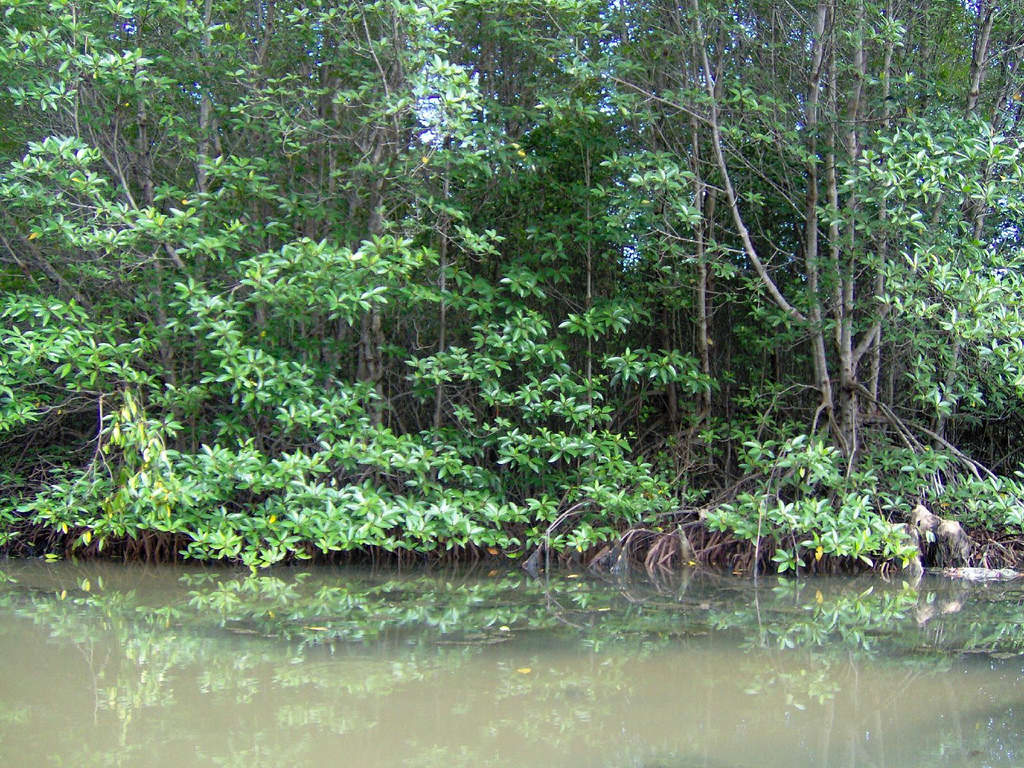The Can Gio Biosphere, or Cần Giờ Biosphere Reserve (Khu dự trữ sinh quyển rừng ngập mặn Cần Giờ) is a wetland nature reserve park 40km away from Ho Chi Minh City. Having been listed the biosphere reserve by UNESCO, it is a vital greenery in Vietnam.
Being a UNESCO site, it promotes international collaboration through education and science. This will help to strengthen relations between difference countries.
It is mainly made of wetland and mangroves, and has many rare species of not only plants but also many animals.
The mangrove forest at Can Gio has many valuable ecological
functions, including coastal stabilisation, and protection against
coastal erosion, oil spills and storm surges. It is a pretty tough plant as it is able to survive in mud and salty water that would normally kill a plant in a few hours thanks to its extremely complex system. They provide nursery grounds for fish and is a food source for many species. Also, their obvious and exposed interlocking roots are to allow slow river flow and can sometimes allow shrimps and lobsters to use it as their home.
All together, it has over 150 species of living things there.
The aim of having Can Gio Biosphere is to reforest unproductive land into something of significance value, in which it has become a nature reserve. The overall aim/function of having this is mainly to increase the amount of natural forest, as a majority of it had been destroyed during the French Revolution or the American War.
Mangroves are various types of trees up to medium height and shrubs that grow in saline coastal sediment habitats in the tropics and subtropics
Red Mangroves, which can survive in the most inundated areas, prop themselves above the water level with stilt roots and can then absorb air through pores in their bark (lenticles). Black Mangroves live on higher ground and make many pneumataphors (specialised root-like structures which stick up out of the soil like straws for breathing) which are also covered inlenticles.
Red mangroves exclude salt by having significantly impermeable roots which are highly suberised, acting as an ultrafiltration mechanism to exclude sodium salts
from the rest of the plant.
Because of the limited fresh water available in salty intertidal soils, mangroves limit the amount of water they lose through their leaves. They can restrict the opening of their stomata.
Mangrove seeds are buoyant and therefore suited to water dispersal. Unlike most plants, whose seeds germinate in soil, many mangroves are viviparous, whose seeds germinate while still attached to the parent tree.
Adapted from:
http://en.wikipedia.org/wiki/Mangrove
http://www.luxurytravelvietnam.com/images/vietnam/Monkey-island-Can-Gio-Ho-Chi-minh-City-Vietnam.jpg
http://img.reitingi.lv/news/2210151006_unesco.jpg
http://upload.wikimedia.org/wikipedia/commons/e/e5/Mangrove_in_Can_Gio_forest.jpg
http://ngm.nationalgeographic.com/2007/02/mangroves/warne-text
http://en.wikipedia.org/wiki/Mangrove
http://ngm.nationalgeographic.com/2007/02/mangroves/warne-text
http://en.wikipedia.org/wiki/Mangrove
Done by:
Group 3




Group 3, where is the info on the meaning of being listed as a UNESCO site and the characteristics of mangrove forests (you may research into generic mangrove species found in Southeast Asia if you are not clear what species can be found at Can Gio). Pls complete the above information asap.
ReplyDeleteGroup 3 you still have not done the above research (in my previous comment). What's going on? The info has to be up by tomorrow night since we are visiting Can Gio on Tues.
ReplyDeleteThe purpose of UNESCO is to contribute to peace and security by promoting international collaboration through education, science, and culture in order to further universal respect for justice, the rule of law, and human rights along with fundamental freedom. Thus, UNESCO sites brings countries together through nature reserves and other places of interest, and strengthens the bond between countries.
ReplyDeleteMangroves are various types of trees up to medium height that grow in tropics and subtropics. Various mangrove species tolerate different saline conditions, ranging from brackish water, through pure seawater to water concentrated by evaporation to over twice the salinity of ocean seawater. They prop themselves above the water level with stilt roots and can then absorb air through pores in their bark. Red mangroves exclude salt by having significantly impermeable roots, acting as an ultrafiltration mechanism to exclude sodium salts from the rest of the plant. Because of the limited fresh water available in salty intertidal soils, mangroves limit the amount of water they lose through their leaves. They can restrict the opening of their stomata to prevent too much vapour from escaping the leaves. Aerial roots allow mangroves to absorb gases directly from the atmosphere, and other nutrients such as iron, from the inhospitable soil. Mangroves store gases directly inside the roots, processing them even when the roots are submerged during high tide.
1. The rivers are polluted. Residents staying there have no proper place to dump their trash so they dump it in the rivers.
ReplyDelete2. People need fresh water supply so living near a river is more convenient. People can not dump their waste into the rivers .
3. The place has outstanding cultural or natural importance. It reminds people of the past and preserve the mangrove swamp.
4. The Singapore River. There are statues at the side of the shows what happen in the past at the river
5. The fishes, prawn, toads are alive when they are sold unlike those back in Singapore and the prices here can be bargain.
1.The river water is polluted.People living next to the river have throw rubbish into it.
ReplyDelete2.People cannot afford living in the city so they live near the river.No dumping waste in rivers
3.Outstanding importance.To keep the heritage of the country
4.Merlion.Where the Melion came from
5.The market that we visited sells live animals that cannot be bought in Singapore